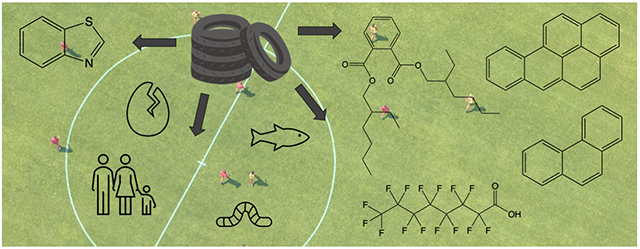Artificial turf has long been marketed as the ultimate playing surface—low maintenance, weather-resistant, and durable. But there’s a dirty secret beneath those synthetic blades: PFAS (per- and poly-fluoroalkyl substances), also known as “forever chemicals.”
Recent reports have found that athletes—especially young ones—are being exposed to these toxic substances at alarming levels simply by playing on artificial fields. So, what does this mean for health-conscious athletes, parents, and coaches? Are we trading convenience for an environmental and health disaster?
Let’s dive deep into the science, the risks, and what needs to happen next.

What Are PFAS, and Why Should Athletes Care?
PFAS are a class of over 15,000 man-made chemicals known for their persistence in the environment and the human body. They are commonly used in non-stick cookware, water-resistant clothing, and—unfortunately—artificial sports turf.
Health Risks Associated with PFAS
Endocrine Disruption: PFAS have been linked to hormonal imbalances, which can affect metabolism, growth, and athletic performance.
Cancer Risk: Studies suggest that long-term exposure increases the likelihood of kidney, liver, and testicular cancers.
Immune System Suppression: Exposure to PFAS can reduce the body’s ability to fight infections, a serious concern for athletes pushing their bodies to the limit.
Developmental Issues: Young athletes face an even greater risk since their bodies are still developing. PFAS exposure has been associated with birth defects and developmental delays.
Liver & Kidney Damage: PFAS have been found to accumulate in these organs, leading to chronic health issues over time.
Reproductive Issues: Some studies indicate that PFAS exposure can lead to decreased sperm count and fertility issues, making this a long-term concern for male athletes.
The Turf Test: Do Athletes Absorb PFAS Through the Skin?
A recent Public Employees for Environmental Responsibility (PEER) study found that three out of four soccer players tested had increased levels of PFAS on their skin after playing on artificial turf. The Washington Post reported that in contrast, no increase was found after games on natural grass fields.
This suggests that direct skin contact is a major route of PFAS absorption. If these chemicals are making their way into an athlete’s bloodstream via sweat and abrasions from falling on the turf, the implications for long-term health are staggering.
More Than Just Skin Deep: PFAS in Inhaled Particles
Another overlooked exposure route? Breathing in tiny PFAS-laden particles. Studies have shown that artificial turf sheds microplastics and dust, which can contain PFAS. Athletes sprinting, diving, and tackling on these surfaces are kicking up clouds of invisible, toxic debris—and inhaling them. Long-term exposure to airborne PFAS has been linked to lung inflammation and cardiovascular issues.
A Global Contamination Crisis: PFAS in Water, Soil, and Food
The problem isn’t limited to athletes alone. Because PFAS are incredibly persistent, they leach from artificial turf into surrounding soil and groundwater, contaminating local drinking water supplies.
PFAS have already been detected in:
Drinking water systems across the U.S.
Freshwater fish at levels deemed unsafe for human consumption
Soils and crops, making their way into the food chain
Given their resistance to breaking down, PFAS contamination will persist for generations unless drastic action is taken.

The Bigger Picture: PFAS in Other Sports Equipment
Artificial turf isn’t the only sports-related culprit. PFAS have been found in rain-resistant sportswear, athletic shoes, and even climbing ropes. For athletes who prioritize performance and durability in their gear, it’s becoming increasingly difficult to avoid exposure to these chemicals.
Are Artificial Turf Companies Pulling a Page From Big Tobacco’s Playbook?
Despite mounting evidence, the Synthetic Turf Council (STC)—the trade association representing artificial turf manufacturers—has been quick to dismiss concerns. In an email to The Washington Post, STC President Melanie Taylor pointed to PFAS in natural soil as a potential counterargument.
Sound familiar? This kind of deflection mirrors the tactics used by the tobacco industry when linking cigarettes to lung cancer.
The reality? PFAS contamination in soil is often due to pesticide use (which is also a major problem), but that doesn’t absolve the artificial turf industry from its role in spreading these toxic compounds across thousands of fields worldwide.
The Lifecycle Problem: What Happens When Turf Is Replaced?
Artificial fields need replacing every 8-10 years. What happens to the old turf? Most of it ends up in landfills or incinerators, releasing toxic compounds into the air and soil. Some companies claim they “recycle” turf, but in reality, much of it is shredded into infill material—which still contains PFAS—and repurposed for playgrounds or secondary athletic fields. It’s an endless cycle of contamination.
What Are Governments Doing About It?
Thankfully, some state governments are stepping in where federal agencies have been slow to act:
New York: Banned the sale of artificial turf containing PFAS starting in 2026.
Massachusetts & Vermont: Considering bills to prohibit new synthetic turf installations at schools.
California: Passed a 2023 bill banning PFAS-containing artificial turf, but Governor Gavin Newsom declined to sign it, requesting stronger enforcement. However, Newsom did sign legislation allowing cities and counties to ban artificial turf locally, prompting municipalities like Millbrae and San Marino to begin restricting synthetic lawns.
This patchwork of legislation is a step in the right direction, but it highlights the need for federal action to regulate PFAS-laden turf nationwide.
The Safer Alternative: Organically Managed Natural Grass
Instead of artificial turf, organically managed grass fields provide a safer and more sustainable alternative. Unlike synthetic turf, natural grass:
Does not contain PFAS
Reduces injury risk due to better shock absorption
Cools naturally, preventing dangerously high surface temperatures (artificial turf can reach 160°F on sunny days)
Supports local ecosystems, improving air and soil quality
The irony? Many school districts and municipalities are spending millions replacing perfectly good grass fields with toxic turf—while organic grass management is often cheaper in the long run.
What Can Athletes and Parents Do?
1. Demand Transparency
Ask schools, parks, and professional sports teams about the materials in their artificial turf. If it contains PFAS, push for safer alternatives.
2. Choose Natural Grass Whenever Possible
If given the option, play on natural grass fields instead of artificial ones. The fewer chemicals you’re exposed to, the better.
3. Advocate for PFAS Bans
Contact local representatives and support legislation banning PFAS in sports fields and playgrounds.
4. Detox Your Body
Since PFAS accumulate in the body, consider ways to support your detox pathways:
Sweat it out through sauna sessions
Stay hydrated with filtered, PFAS-free water
Eat organic, avoiding contaminated food sources
Prioritize liver health with nutrient-dense, whole foods
The Bottom Line: Do We Want to Keep Playing on Toxic Fields?
The evidence is clear: PFAS in artificial turf is a serious health risk that can no longer be ignored. As athletes, coaches, and parents, it’s time to demand safer alternatives and hold manufacturers accountable.
Playing the sport you love shouldn’t mean exposing yourself to chemicals linked to cancer, endocrine disruption, and immune system suppression. It’s time for the industry to clean up its act—or for us to take our game elsewhere.







